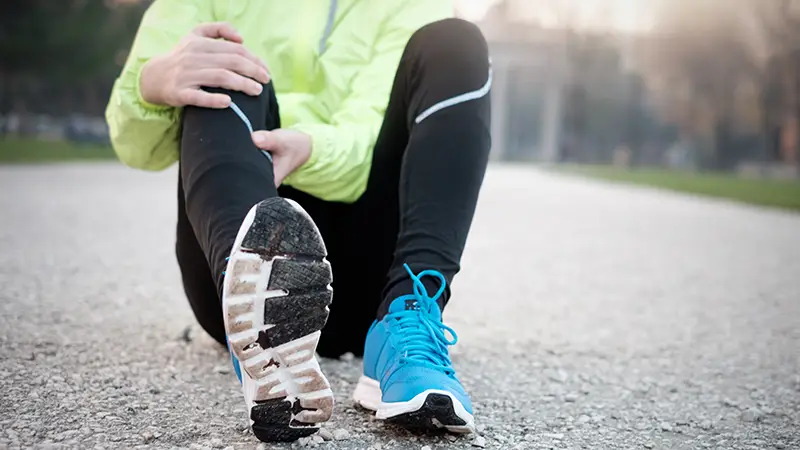Many runners experience a decrease in their running performance at some point in their training.
It can be frustrating to feel like you’re putting in the effort but have to ask yourself why am I getting slower at running?
There are many reasons someone might get slower at running, and it’s important to identify the cause to make the needed adjustments.
Contents
One common reason for slowing down is overtraining.
If a runner is pushing themselves too hard without proper rest and recovery, their body may not keep up with the demands being placed on it.
This can lead to fatigue, injury, and a decrease in performance.
It’s important for runners to listen to their bodies and take rest days when needed to prevent overtraining.
Another factor that can impact running performance is nutrition. The food a runner eats provides the fuel and nutrients needed to power their workouts.
If a runner isn’t eating enough or isn’t consuming the right foods, they may not have the energy needed to perform at their best.
It’s important for runners to fuel their bodies with a balanced diet that includes plenty of carbohydrates, protein, and healthy fats.
Why Am I Getting Slower at Running: Solutions
Assessing Your Progress
One of the most important things to do when trying to improve your running speed is to assess your progress regularly.
You can do this by keeping track of your running times and distances, and by noting how you feel before, during, and after your runs.
By doing this, you can identify patterns in your running performance and make adjustments to your training regimen accordingly.
Setting Realistic Goals
Setting realistic goals is another important strategy for improving your running speed.
This means setting achievable goals that are challenging but not impossible.
For example, if you currently run a 10-minute mile, setting a goal to run a 6-minute mile in a month is not realistic.
Instead, aim to shave a few seconds off your current time each week until you reach your ultimate goal.
Variety in Training
Variety is key for improving your running speed.
This means incorporating different workouts into your training regimen, such as interval training, hill repeats, and tempo runs.
By doing this, you can challenge your body in different ways and prevent boredom and burnout.
Strength Training for Runners
Strength training is also important for improving your running speed.
This means incorporating exercises that target your legs, core, and upper body into your training regimen.
Examples of strength training exercises for runners include squats, lunges, planks, and push-ups.
Using Apps and Programs
Finally, using apps and programs can also be helpful when trying to improve your running speed.
There are many apps available that can track your progress, provide training plans, and offer motivation and support.
Some popular running apps include Nike Run Club, Strava, and Runkeeper.
Overall, improving your running speed requires a combination of solutions and strategies.
By assessing your progress, setting realistic goals, incorporating variety into your training, incorporating strength training, and using apps and programs, you can reach your running goals and improve your overall fitness.
Understanding the Running Slower Phenomenon

Many runners experience a plateau or even a decline in their running performance.
It can be frustrating to put in the effort and not see any improvement or even see a decline in pace.
Here are some reasons a runner might slow down:
Overtraining
One of the most common reasons for slowing down is overtraining.
When a runner pushes themselves too hard without adequate rest and recovery, their body can’t keep up, and their performance suffers.
It’s essential to listen to your body and take rest days when needed.
Lifestyle factors
Stress, sleep, and diet can all impact running performance. Lack of sleep can lead to fatigue, making it harder to maintain a faster pace.
Stress can also affect performance, as it can lead to tension and tightness in muscles, making it harder to run efficiently.
A poor diet can lead to a lack of energy and nutrients needed for optimal performance.
Lack of variety in training
Repeating the same workouts can lead to a plateau in performance.
It’s important to mix up the training routine with different runs, such as speed work, tempo runs, and long runs.
This variety can help prevent boredom and stimulate different muscle groups, leading to improved performance.
Age
As we age, our bodies naturally decline in performance. It’s essential to adjust expectations and training accordingly.
Older runners may need more rest and recovery time than younger runners and may need to adjust their pace and distance goals.
Injury
Injuries can also lead to a decline in performance. It’s necessary to address injuries promptly and take the needed time off to recover fully.
Pushing through an injury can lead to further damage and longer recovery times.
With patience and persistence, runners can overcome plateaus and continue to improve their performance.
The Role of Age and Fitness
Aging and Performance
As people age, their physical performance tends to decline because of various factors such as decreased muscle mass, reduced maximum heart rate, and a decline in lung function.
According to Livestrong, the maximum heart rate decreases as people age, which can decrease how intensely they can exercise.
The American College of Sports Medicine states that muscle strength and mass begin decreasing at age 40, with the process speeding up after age 75.
All these factors can contribute to a decline in running performance as people age.
Fitness Level and Running Speed
Fitness level plays a significant role in running speed. The more fit a person is, the faster they can run.
According to Runner’s World, runners who maintain their fitness level can slow down their rate of decline in running speed.
A study found that between age 40 and 70, runners slowed by a linear rate of about one percent each year. When runners reached their late 70s, they declined by about 1.5 percent.
It’s important to note that fitness level is not just a function of age. People of all ages can improve their fitness level and slow down the rate of decline in running speed.
Regular exercise, strength training, and a healthy diet can help maintain fitness levels and improve running performance.
According to a study cited by Women’s Running, only about half of the fitness losses suffered by endurance athletes as they get older are because of the passage of time.
The other half can be chalked up to reduced training.
In summary, age and fitness level play a significant role in running performance.
While aging is inevitable, people can slow down the rate of decline in running speed by maintaining their fitness level through regular exercise, strength training, and a healthy diet.
Impact of Training
Training is an essential aspect of running, and it can significantly affect the runner’s performance.
The following sub-sections explain how training intensity, volume, and cycle can impact running performance.
Training Intensity
Training intensity is the level of effort put into a workout. We can measure it using various methods, such as heart rate, pace, or perceived exertion.
Training intensity can have a significant impact on running performance.
If a runner trains at a high intensity consistently, they can experience fatigue, which can cause slower running times.
On the other hand, if a runner trains at a low intensity, they may not see improvements in their running performance.
Training Volume
Training volume refers to the amount of training a runner does. This includes the number of workouts and the duration of each workout.
Training volume can impact running performance in several ways.
If a runner increases their training volume too quickly, they can experience fatigue and may not see improvements in their running performance.
On the other hand, if a runner does not train enough, they may not see improvements in their running performance.
Training Cycle
The training cycle refers to the periods of a runner’s training plan.
A training plan typically includes different phases, such as base training, speed training, and tapering.
The training cycle can impact running performance in several ways. If a runner does not follow a proper training cycle, they may experience fatigue, which can cause slower running times.
However, if a runner follows a proper training cycle, they can see improvements in their running performance.
It is essential to find the right balance between training intensity, volume, and cycle to achieve optimal running performance.
The Importance of Rest and Recovery

Rest and recovery are essential for runners to achieve their peak performance.
Many runners make the mistake of thinking that training harder and longer will lead to better results, but this is not always the case.
In fact, overtraining and not allowing enough time for rest and recovery can lead to decreased performance and even injury.
Sleep and Performance
Sleep is a crucial component of rest and recovery for runners. During sleep, the body repairs and rebuilds muscles that have been broken down during exercise.
Sleep helps to regulate hormones that are important for athletic performance, such as growth hormone and cortisol.
Sleep deprivation, on the other hand, can have a negative impact on athletic performance.
Studies have shown that lack of sleep can lead to decreased reaction time, decreased endurance, and increased risk of injury.
Therefore, it is important for runners to prioritize getting enough sleep each night.
Overtraining Syndrome
Overtraining syndrome is a condition that occurs when a runner trains too hard and does not allow enough time for rest and recovery.
Symptoms of overtraining syndrome include fatigue, decreased performance, and increased risk of injury.
To avoid overtraining syndrome, runners should incorporate rest and recovery into their training plans.
This can include taking rest days, cross-training, and incorporating recovery activities such as foam rolling and stretching.
Rest and recovery are crucial components of a runner’s training plan. By prioritizing sleep and avoiding overtraining syndrome, runners can achieve their peak performance and avoid injury.
Diet and Nutrition

Maintaining a healthy diet is crucial for runners to perform at their best.
The right balance of nutrients can help increase energy levels, improve endurance, and prevent injuries.
Below are some important factors to consider with diet and nutrition for runners:
Caloric Intake and Energy Levels
Caloric intake plays a significant role in a runner’s performance.
Consuming too few calories can lead to low energy levels, which can affect endurance and performance.
On the other hand, consuming too many calories can lead to weight gain and slow down running pace.
It is important for runners to maintain a balanced diet that provides enough calories to fuel their runs and support their overall health.
A good rule of thumb is to consume around 15-20 calories per pound of body weight per day, depending on activity level and goals.
Hydration and Running
Proper hydration is crucial for runners to perform at their best.
Dehydration can lead to fatigue, muscle cramps, and other health issues.
We recommend drinking at least 8-10 cups of water per day, and more if you are running in hot or humid conditions.
During long runs, it is important to replenish fluids, and electrolytes lost through sweat.
Sports drinks and electrolyte supplements can help maintain hydration levels and improve performance.
Iron and Running Performance
Iron is an essential nutrient for runners, as it helps transport oxygen to the muscles and improves endurance.
Iron deficiency can lead to fatigue, decreased energy levels, and poor performance.
To ensure adequate iron intake, runners should consume iron-rich foods such as lean meats, beans, spinach, and fortified cereals.
It is also important to consume vitamin C-rich foods such as citrus fruits and tomatoes, which can help improve iron absorption.
Overall, maintaining a balanced and nutrient-rich diet is essential for runners to perform at their best.
By paying attention to caloric intake, hydration levels, and iron intake, runners can improve their endurance, prevent injuries, and achieve their goals.
Physical Factors

Weight Gain and Running
Weight gain can play a significant role in slowing down a runner.
Extra weight can put pressure on the back and legs, making it harder to maintain the same pace as before.
When a person gains weight, their muscles have to work harder to carry the extra weight, which can cause fatigue and slower running times.
One way to combat weight gain is to watch what you eat. A healthy diet that is rich in fruits, vegetables, and lean proteins can help you maintain a healthy weight.
Incorporating strength training exercises into your routine can help you build muscle and boost your metabolism, which can help you burn more calories and maintain a healthy weight.
Running Injuries
Injuries can also slow down a runner.
When a person experiences an injury, they may need to take time off from running to allow their body to heal.
This can cause a loss of fitness and a slower running pace when they return to running.
Common running injuries include shin splints, plantar fasciitis, and stress fractures.
To prevent injuries, runners should warm up properly before running, wear proper footwear, and gradually increase their mileage.
If an injury occurs, it is important to rest and allow the body to heal before returning to running.
Besides these physical factors, there are also internal factors that can contribute to a slower running pace. These factors include stress, lack of sleep, and inadequate nutrition.
By addressing these factors, runners can improve their overall health and potentially improve their running performance.
Psychological Factors

Running is not just a physical activity but also a mental sport. Psychological factors can play a crucial role in determining a runner’s performance.
Below are some of the psychological factors that can affect a runner’s speed and endurance:
Stress
Stress can have a significant impact on a runner’s performance.
When a runner is stressed, their body produces cortisol, which can increase heart rate and muscle tension.
This can lead to decreased endurance and slower running times. It is essential to manage stress levels to prevent it from affecting running performance.
Goals
Setting goals can be a great motivator for runners.
However, if the goals are unrealistic or too challenging, it can lead to disappointment and demotivation.
If the goals are too easy, it can lead to complacency.
It is crucial to set achievable and challenging goals to stay motivated and improve running performance.
Psychological Factors
Psychological factors such as anxiety, depression, and self-doubt can also affect a runner’s performance.
Anxiety can lead to racing heart and hyperventilation, which can affect breathing and running performance.
Depression and self-doubt can lead to decreased motivation and energy levels, which can lead to slower running times.
It is essential to address any psychological issues to prevent them from affecting running performance.
Environmental Factors
There are many environmental factors that can affect running performance.
Two of the most significant factors are the season and the surface you are running on:
Running in Different Seasons
The season can have a significant impact on running performance.
For example, running in the summer can be more challenging than running in the winter. This is because high temperatures, heavy winds, and extra humidity might slow you down.
Running in the winter can also be difficult (even though most runners prefer it) because of the cold weather.
Cold weather can affect your running performance because it changes the way your body metabolizes fuel.
When you run in the cold, your body uses up its glycogen stores at a much higher rate than when you run in warmer temperatures.
This can lead to fatigue and a decrease in performance.
Running on Different Surfaces
Another environmental factor that can affect running performance is the surface you are running on.
Different surfaces have different impacts on your body.
For example, running on concrete can be hard on your joints, while running on grass or dirt can be easier on your body.
Additionally, running on hills can be more challenging than running on flat ground.
This is because running uphill requires more energy and can cause more fatigue.
It is important to consider the environmental factors when training for a race or trying to improve running performance.
By adjusting training to account for these factors, runners can improve their performance and avoid injury.
Some tips for adjusting training based on environmental factors include:
- Running in the early morning or late evening during hot summer months
- Wearing appropriate clothing for the season
- Staying hydrated during hot weather
- Warming up properly before running on hard surfaces
- Varying running routes to include different surfaces and terrains
Overall, environmental factors can play a significant role in running performance.
By understanding and accounting for these factors, runners can improve their performance and stay healthy.
